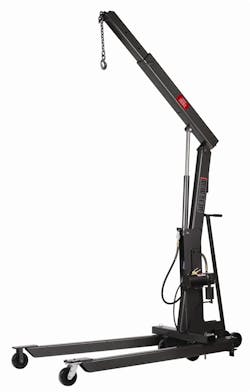Floor cranes and the technician
A floor crane can be called many things by technicians, such as a shop crane or a cherry picker.
“Regardless of what it is called the floor crane can be a valuable addition to any shop's tool list,” says Todd Michalski, vice president, Gray Manufacturing Company (grayusa.com), a family owned and operated business specializing in manufacturing and selling portable lifting equipment for use by professional technicians. These cranes “can help improve shop and technician productivity and safety in a variety of ways.”
Floor cranes are used for lifting, shifting and moving heavy items – such as engines, radiators, engine heads and driveline components – in and around the shop, he explains. Without such shop equipment, such tasks “can be very time consuming, require a lot of energy from the technician and be a serious safety hazard.”
REPETITIVE LIFTING
The main advantage of having a quality floor crane is the handling of repetitive lifting with minimal effort required by the technician, says Gray Manufacturing’s Michalski. “Repetitive lifting throughout the workday creates large energy drains from the technician, which can lead to lower productivity, decreased quality of work and greater risk of accidents or injury.
“Lifting injuries to a technician's back tend not to happen with a single event, but damage accumulates over time, creating chronic problems,” he goes on. “The use of a floor crane can help prevent injuries and extend the productive career of the technician.”
Floor cranes will help with many tough lifting jobs while easily maneuvering the items around the shop, adds Michalski. Moreover, they offer “a more flexible option than overhead cranes because the technician can take the crane to the work and does not have to take the work to the crane.”
WHAT TO LOOK FOR
When investing in a shop crane, Michalski says there are some factors to consider.
- Construction of the crane. A rugged, well-manufactured frame using quality materials will help extend the life of the crane.
- Storage. In some shops storage is a major problem, so determining how easily and completely the crane folds up for compact storage may be a key factor.
- Adjustability. When using a floor crane, the legs may cause clearance issues. In such an instance, look for a crane with adjustable legs for better clearance options.
- Speed. A crane with a high-quality 2-speed hydraulic lifting cylinder provides efficient, long-lasting and precise operation. A crane with an air-operated system can improve speed and productivity.
- Boom Extension. Understand how far the telescopic boom extends and the coinciding lift capacity as it extends.
- Industry Standards. Make certain the floor crane being considered meets all of the current industry standards for safety.
